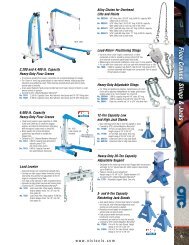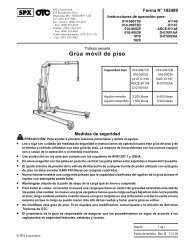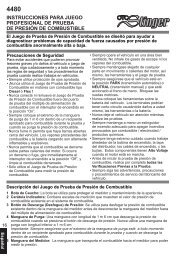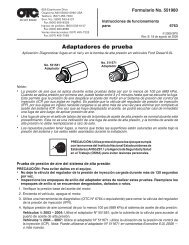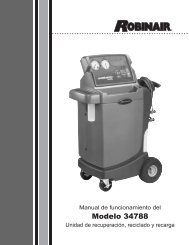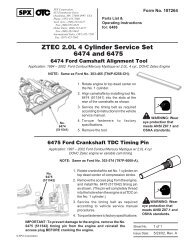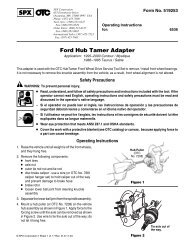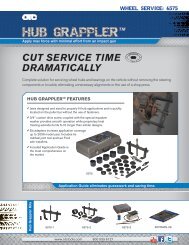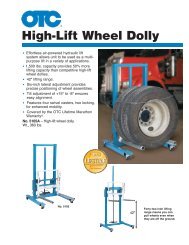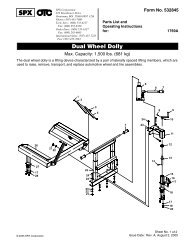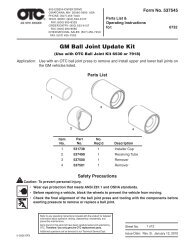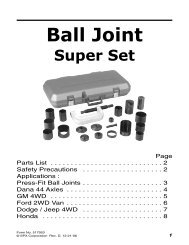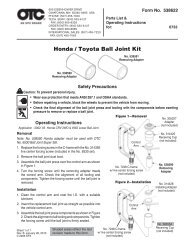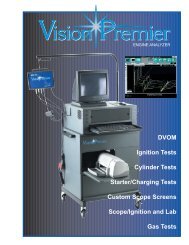ABS/SRS Code Reader OBDII Scan Tool User's Guide - OTC
ABS/SRS Code Reader OBDII Scan Tool User's Guide - OTC
ABS/SRS Code Reader OBDII Scan Tool User's Guide - OTC
You also want an ePaper? Increase the reach of your titles
YUMPU automatically turns print PDFs into web optimized ePapers that Google loves.
2<br />
Getting Started<br />
<strong>ABS</strong> Configurations<br />
<strong>ABS</strong> has had three different configurations for distribution of wheel<br />
speed sensors and hydraulic lines from the hydraulic control unit since<br />
its conception.<br />
The earliest <strong>ABS</strong> configuration used one wheel speed sensor that<br />
monitor the speed of both rear wheels. If the rear wheels would lock up,<br />
the <strong>ABS</strong> computer would pulse a solenoid in the hydraulic control unit,<br />
which would then change the brake fluid hydraulic pressure applied to<br />
the rear wheels.<br />
The next evolution in <strong>ABS</strong> added wheel speed sensors to both front<br />
wheels, while still having a single wheel speed sensor in the rear to<br />
monitor both rear wheels. Under this system, if the left front, right front,<br />
or both rear wheels rotate at a speed different from each other, the <strong>ABS</strong><br />
computer could use up to three separate solenoids to control brake fluid<br />
hydraulic pressure. This allowed the <strong>ABS</strong> system to control the left front,<br />
right front, and both rear wheels together independently.<br />
Today, some vehicles have one wheel speed sensor per wheel for a<br />
total of four. On these vehicles, the <strong>ABS</strong> computer can independently<br />
control brake fluid hydraulic pressure on every wheel.<br />
<strong>ABS</strong> Repair Tips<br />
• Before servicing the <strong>ABS</strong>, refer to the manufacturer's recommendations.<br />
• Torque the wheel lug nuts properly to avoid bending a rotor or drum, which<br />
can cause inaccurate wheel speed sensor readings.<br />
• Bleed the brake system properly.<br />
• When necessary, always add fresh brake fluid to the master cylinder.<br />
• Always replace tires with the manufacturer's recommended size.<br />
• Always rotate tires as recommended by manufacturer.<br />
• When interpreting DTCs retrieved from the vehicle, always follow the manufacturer's<br />
recommendations for repair.<br />
Supplemental Restraint System<br />
Supplemental Restraint System (<strong>SRS</strong>) is a vehicle safety device which<br />
was introduced in the 1970s. Its purpose is to supplement the<br />
over-the-shoulder seatbelt to help prevent vehicle occupants from<br />
hitting interior objects such as steering wheels, dashboards, and the<br />
like. Vehicles can and often do contain multiple airbags in various<br />
locations throughout the vehicle.<br />
How <strong>SRS</strong> Works<br />
The <strong>SRS</strong>, or airbags, are activated through a central Airbag Control Unit<br />
(ARU). The ARU monitors sensors such as wheel speed,<br />
accelerometers, brake pressure, seat occupancy, and in some cases<br />
gyroscopes, to provide a basic threshold. When the threshold is<br />
2 – 2 • • • • • • • • • • • • • • • • • • • • • • • • • • • • • • • • • • • • • • • • • • • • • • • • • • • • • • • •



